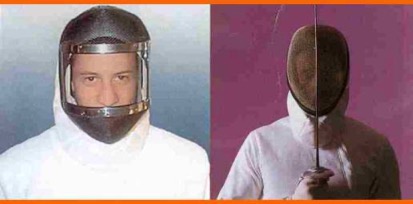Vision 2000 Mask (2001)
In preparation for the 2000 Olympics, the Leon Paul Company introduced the Vision 2000 Pro-Fencing mask. This was intended to replace the existing wire mesh masks by adding a polycarbonate visor to improve vision for the fencers, and also increase the appeal of the sport to spectators - as they would be able to better see the expressions of the competitors.

Abstract
A fencing mask with a transparent polycarbonate visor has recently been introduced which replaces the conventional metal mesh mask. The visor is constructed using two polycarbonate sheets, one forming the structural layer and the other a removable scratch plate. This multilayer system has inherent disadvantages with regard to optical transmission, since the intensity of reflected light is related to the difference in refractive index of the materials. As such, a large step change in refractive index leads to greater reflective losses, thereby lowering the intensity of transmitted light. The magnitude of this reflective loss may be calculated using the Fresnel equations.
Light scattering and the appearance of a ‘ghost’ image are a manifestation of the Fresnel reflections. Light reflected at one surface undergoes internal reflection and thus appears to originate in a different optical plane. Since there are reflective losses at every interface, it is essential to reduce the reflectivity at each step.
Results presented here show that the optical properties of an air-filled multilayer system offer substantially lower transmission than a liquid-filled structure. Modelling of this simple modification to the existing mask design has been shown to increase the theoretical transmission of light by a minimum of 7%, with experimental work substantiating these findings.
RJ Holmes, NJ Goddard, K Singh, and S Mohr. Improving the Optical Characteristics of a Polycarbonate Fencing Mask, J. Sports Engineering (2001) 4, pp 225 – 231
https://doi.org/10.1046/j.1460-2687.2001.00068.x![]()